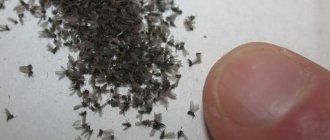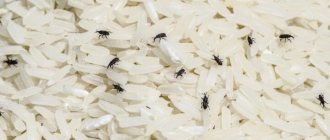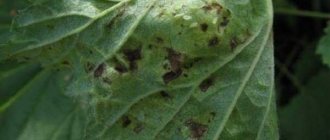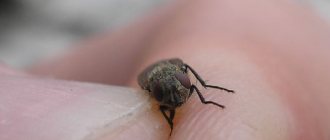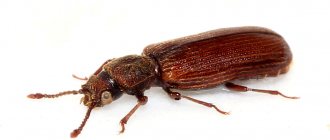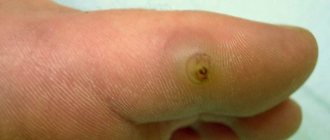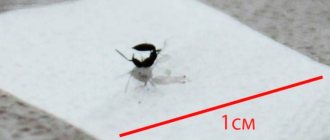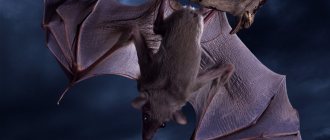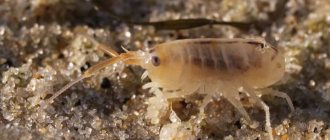Everyone knows nasty black midges - they appear where there is constantly high humidity and food waste accumulates. Nasty insects are annoying just by their presence in the room, but do they cause harm if they swarm over flower containers with green pets? Many gardeners consider midges in orchids to be harmless and do not harm indoor plants. But is this really so?
In Europe alone, from the huge little-studied family of Leaf, or soil, mosquitoes (Sciaridae), almost 600 species of dipterous insects are known, not exceeding 7 mm in length. Their body on thin legs is almost black, their wings are also dark, and long antennae stick out in front. The larvae are white, narrowly cylindrical, with a black head, which is more correctly called a sclerotized capsule.
Adults of most species do not have mouthparts and do not feed, which is why they live for several days. Decomposing plant tissues, algal and bacterial deposits, and fungal mycelium are suitable as food for nymphs. However, there are some species that feed on plant roots.
What kind of mosquitoes live in pots of orchids?
Two species have been observed on orchids, representing two different genera of sciarids: Darkwings, or fungus gnats (Sciara) are black adults, 4–6 mm long. Up to 200 eggs are laid in a moist orchid substrate, from which miniature worms without limbs, transparent white in color, with a dark head 4–7 mm long, appear. They prefer to settle in a moist substrate containing sphagnum moss and peat in predominant quantities.
They feed on plant debris while the colony is small, but as their numbers increase, they begin to eat the tips of young roots and young tissue in the lower part of the plant. The life cycle is short - it takes about a month from egg to adult insect. They do not cause devastating harm to orchids, but they significantly weaken the plants and facilitate the penetration of infections through wounds on gnawed roots.
Cucumber gnats (Bradysia brunnipes) are dipterous insects 3.4-4.5 mm long with a dark gray body, brownish wings and yellowish long legs. Outwardly they differ little from fungus gnats, but, unlike them, they prefer to settle not in indoor pots on the window, but in orchidariums or greenhouses.
Females are larger than males and lay up to 240 eggs in the moist top layer of the substrate. After 5–10 days, larvae appear. Although this is an atypical pest of orchids, it can attack them too. The worms make passages in the roots and stems of plants, after 12 days they pupate, becoming covered with a white cobweb cocoon, from which, after another couple of weeks, adults fly out, capable of producing offspring.
Methods of treatment.
There are a great variety of ways to treat plants from sciarid invasion. First of all, it is advised to reduce watering the plant so that the soil dries to a depth of 2.5-5 cm. However, from my own experience I cannot call this measure at all effective. Reducing watering of Saintpaulias, for example, led me to their terrible dissatisfaction; the plants dropped their leaves and looked offended and depressed. And the sciarids flew and continued to fly. Of course, such abuse of plants must be continued long enough to starve out the hated mosquitoes, but, unfortunately, not every flower can withstand a period of prolonged drought, and there are some for which it is generally contraindicated.
You can try to catch flying insects with a vacuum cleaner or with yellow adhesive tape, which is best placed horizontally relative to the soil. You can water the soil with water with citromon or askofen (half a tablet per 3-4 liters of water).
Sometimes sticking half a clove of garlic or orange peels into the soil helps. It is recommended to use means to combat blood-sucking insects such as “Raptor”, various aerosols, fumigators, etc. However, fighting adult insects does not help in any way to get rid of the larvae.
You can also coat the edge of the pot with all the well-known Mashenka chalk.
You can remove the top layer of soil to a depth of 1.5-2 cm and replace it with sand. Insects do not lay eggs in sand, which will ensure quick disposal of sciarids. You can lure the larvae using potatoes. Small cubes of potatoes or carrots (about 3.5 cm) should be placed on the surface of the soil for 2-3 days. The larvae will crawl straight to it and begin to actively eat. Soon you will be able to see how many of them have gathered under the potatoes. It, of course, will need to be removed along with the larvae to prevent rotting.
I don't think the damage caused by sciarids is so great that insecticides need to be used. However, if you do not have any prejudices against chemistry (and in vain), and the number of insects has become simply catastrophic, you can water the soil with Aktara. In general, insects multiply very strongly, mainly in winter, when the heating is on. In the spring, if the humidity in the apartment decreases, the number of insects drops sharply.
The article uses photos from the following sources:
Reasons for the appearance of midges in orchids and ways of getting into the house
Fungus gnats are attracted to weakened plants with decaying substrate that is not allowed to dry out. The ideal place for propagation, in addition to the substrate, is the flower tray located in a shaded, damp place.
Sciarids lay eggs in the contents of pots with growing paphiopedyllums, miltonias, masdevallias and other terrestrial orchids; a soil mixture with humus is especially attractive to them. Orchids that are grown in bark are less attractive to midges, unless the substrate has long expired.
Mosquito eggs enter the room with purchased soil. Experienced orchid growers advise not to plant flowers in it right away, but to observe for several days to see if midges are flying over it, or to heat it or pour boiling water on it, thus disinfecting it from other possible pests and diseases.
Adults enter the apartment through an open window or through ventilation, sometimes they are brought in with bouquets of flowers or spoiled vegetables from the market.
Why is it dangerous?
It should be noted that no sciarid attacks on humans were observed. They do not suck blood or bite. To confirm these facts, American scientists specifically conducted research. Ground mosquitoes do not fly near your face. But, despite this, they can carry various dangerous diseases that harm not only plants, but also humans. For example, the disease can be transmitted through contact with infected flowers. Or if a person inhales mold spores that are carried by sciarid flies.
Mosquitoes negatively affect plant health. If larvae appear en masse in the soil, flowers will not develop and their appearance will deteriorate. Accordingly, they become lethargic. It can even go as far as lack of flowering. If a person notices all these signs in plants, it is necessary to quickly get rid of the insects.
Symptoms of the presence of midges in orchids
Insects are not difficult to see; above a pot with an orchid, a swarm of black midges is clearly visible, and on the leaves and fragments of the substrate they are noticeable with the naked eye. However, you can only determine whether they are harmful by removing the plant from the pot.
The orchid, one way or another, will have to be replanted, because the very fact of the appearance of a large number of midges already tells the gardener that not all is well with the substrate. Therefore, it is necessary to make sure that everything is in order with the orchid’s root system and replant it in a fresh soil mixture that excludes mold fungi and green algae deposits.
During transplantation, the roots are carefully inspected, washed in a weak solution of potassium permanganate, and the wounds, if any, are sprinkled with activated carbon powder or cinnamon to prevent bacterial or fungal infections from entering them. The transplanted plants are kept more dry than usual for 4–7 days.
What does an insect look like?
Sciarides are a family of insects. This includes the fungus gnat or, in other words, the sciara fly. The insect represents the order Diptera.
The mosquito is small in size - up to 4 mm. The body is narrow and oblong in shape. The flying insect is black and gray in color. A characteristic feature is that the color becomes darker as they grow older. The fungus gnat has a round head with long antennae. The insect also has colorless fore wings. Despite this, they are endowed with the ability to fly.
The insect has small transparent wings
People's Councils
To do this, they use sticky tapes that are hung next to the plants - for some reason, midges prefer to sit on yellow tape. Yellow saucers with a sweet liquid or special granules for flies also catch insects.
Some orchid growers grow carnivorous plants next to their orchids - Venus flytrap, sundew or butterwort, while others plant a small onion-garlic “vegetable garden” in small containers next to their collection of exotic plants.
Insecticidal plants are also used to repel flying insects: marigolds, calendula, wormwood, yarrow or tobacco from a gutted cigarette are laid dry on top of the substrate in a pot. Infusions of these plants are prepared and the soil is spilled to destroy the larvae.
Measures to control soil flies
If a swarm of fungus gnats is discovered, it is better to immediately take radical measures. You need to fight the sciarids on two flanks - from the air and on the ground. If you poison only flying individuals, then new sciarid larvae will hatch in the soil every day.
To destroy the larvae, you need to use a solution of insecticides. I would like to immediately warn you that the more powerful the drug, the more effective the fight. For example, a solution of fitoverm may be ineffective in some cases. Actellik (2 ml/l), Decis or Karbofos are best suited. Do not be afraid of causing harm to the plant; almost all produced drugs for controlling pests and diseases are not phytotoxic. If “nests” or clutches of fungus gnats are found in more than one pot and the flies fly, as they say, in flocks, then it is better to re-treat with an insecticide during the next watering.
You will also have to fight flying insects; for this it is better to use the same means that are used to fight flies. These are aerosols, like the well-known dichlorvos and the like. Sometimes you can come across a recommendation to use “Raptor” or “Fumitox” plates in such a case, but they are usually not very effective. If many of us have more than once encountered the fact that, having turned on, say, “Raptor” at night, some very persistent mosquito was still discovered in the morning, then what can we say about sciarids - you cannot completely rely on these remedies, even if change records quite often. Although you can try these products first, the main thing is to tightly close the aquarium, if you have one. If within an hour after turning on the “anti-mosquito” plates (although they can be in liquid form) the sciarids do not die, then you can take on dichlorvos.
If fungus gnats breed in winter, then it is best to take the plants (already watered with insecticide) into a separate room or stairwell (as long as the neighbors don’t notice) and spray the soil in the pots with an aerosol from above. After two minutes, the plants can be brought in and left, for example, in the bathroom. The room where the plants stood was also treated with an aerosol and thoroughly ventilated after half an hour. Flowers can be brought in only when the room becomes warm. If sciarids appear in your home in the summer, then the easiest way is to take all the plants to the balcony (outside) and carry out all treatments there.
In pest control, all means are good, as long as there is no harm to the plants, so clap your hands and catch flying flies with a vacuum cleaner.
Treatment of the room and pots with plants with aerosols against flying insects, as well as watering the soil with insecticides, may have to be repeated, preferably until the pests completely disappear.
Prevention measures for sciarids
Do not use food products or infusions from them to feed plants. Such as meat or fish broths, drunken tea, sugar water, milk, etc. Indoor plants have a physiology not like that of humans; while food products decompose into components that are easily digestible by plants, but simply rot, entire collections of pests can settle and multiply on plants and in the soil.
If you are going to feed the plants with organic matter, such as mullein, then it is better to do this without watering the cow dung infusion, but by adding it to the soil when replanting. The most convenient option is to smear the walls of an empty pot up to the middle of their height with a semi-liquid cake, then place the plant and fill the space between the roots and the walls of the pot with earth. In this case, the smell of rotting manure does not remain.
If you have a lot of plants, especially those that like moist soil, then it makes sense to switch to tray watering to keep the top layer of soil dry. But at the same time, we must remember that the water in the pan should be fresh, and not sour, with the appearance of swamp mud.
Timely control of emerging insects can also be considered an important preventative measure. It is impossible to start the reproduction of sciarids to such an extent when they already fly in flocks. Otherwise, you may not find a single plant that is not affected by larvae, no matter how good the soil is.
In order to prevent any pests and diseases, soil purchased or prepared by yourself must be disinfected (steamed with boiling water, fried in the oven, sprayed with insecticide, kept in the freezer, etc.).
Chemicals
Radical measures have to be taken when the substrate is already swarming with larvae; it is enough to lift its top layer 1 cm thick to detect them. Unfortunately, many chemicals are toxic and their use in residential areas is undesirable. It is advisable to move orchids affected by midges to a glazed balcony or veranda and spray there.
In enclosed spaces, treatment with the drugs Largon, Mikromit, Difluorobenzuron is allowed, which can destroy adults and larvae; Intavir and Carbofuran are considered stronger. Teflubenzuron affects the life cycle of sciarids and inhibits the process of transformation of larvae into adults, thus preventing an increase in the size of the colony.
Flower growers speak well of the granular product Grom-2, which is scattered on the surface of the substrate and lightly mixed with the top layer. Its consumption rate per 1 sq. m area is only 1-1.5 g, and it is effective until the granules are completely dissolved within 14 days.
Bayer products are considered harmless to humans, which are used both to prevent the appearance of sciarid larvae and to get rid of adult insects. When using the drugs Regent and Regent-800, you should carefully calculate the dosage. If the standard recommended solution is 1 g in 10 liters of water, then for orchids this norm is reduced by at least half. Finally, proven methods of combating house flies are used - Dichlorvos, Raptor sprays, and against larvae - Fly eater.
Preventive measures
The most important thing in preventing the appearance of insects is to block their access from the outside. To do this, there must certainly be a dense, dense mesh on the ventilation openings. It needs to be replaced with a new one several times a year. You can periodically apply products with an unpleasant odor to the mesh, which insects do not like. If possible, rub it with any pest repellent chalk.
We suggest you read: How to get rid of empty nits
Cleanliness of the room and timely cleaning of rotting parts of the mycelium will also help prevent the appearance of insects - mosquitoes will not appear in a sterile environment. Wash all surfaces weekly with lime chloride.
Potassium permanganate solution
Water the compost several times a month with a solution of potassium permanganate. A concentrated mixture is not needed, a slightly pink tint is enough. This will not affect the future harvest, but will effectively protect against uninvited guests.
Regularly replace the topsoil with fresh soil. Compost must be sterilized before use. Also purchase only high-quality soil in specialized stores. Buy mycelium from trusted sellers.
You can get rid of small flying pests in the mycelium, but only by getting to work immediately after detecting them. The effect will increase if the treatment is carried out comprehensively. But it’s even better to prevent insects from appearing by carrying out preventive work.
To grow indoor plants, you should use only clean substrate that is not contaminated with larvae. Buy packaged soil in specialized stores, and if you prepare the soil for your plants yourself, then you need to be able to process it correctly. To cultivate the land for planting, first it should be well moistened, allowed to drain, and then placed in the freezer to freeze.
What to do to get rid of fungus gnats
First, determine their number and the “front” of the fight against insects, then select the appropriate measures:
- Determine how the mosquitoes got to you and think about possible habitats. Carefully inspect the area for food debris.
- Check hoods, grilles leading to basements and ventilation shafts. Since it is hardly possible to eliminate moisture in basements, you will have to fight it using available means: install a mesh on the ventilation grilles, with fairly small cells, so that mosquitoes do not get through it.
- Inspect the soil in the flowerpots for the presence of larval eggs and check the condition of the roots of the flowers; if necessary, replace with fresh substrate.
- There should be good air circulation in the room where flowerpots are located.
Prevention.
It is not advisable to water the plants too much, because... Fungus gnats develop most intensively in moist soil. In soil mixtures from some manufacturers, fungus gnats are almost always present. Therefore, the soil must be sterilized before use. Sometimes mulching helps prevent the appearance of sciarids and reduce their number - you can cover the soil with a layer of sand or a cut out circle of paper. You cannot water plants with various “folk” remedies such as tea, broth or water left after meat. You should also regularly remove dry leaves and other organic debris from the soil surface, which serve as good food for the larvae.

